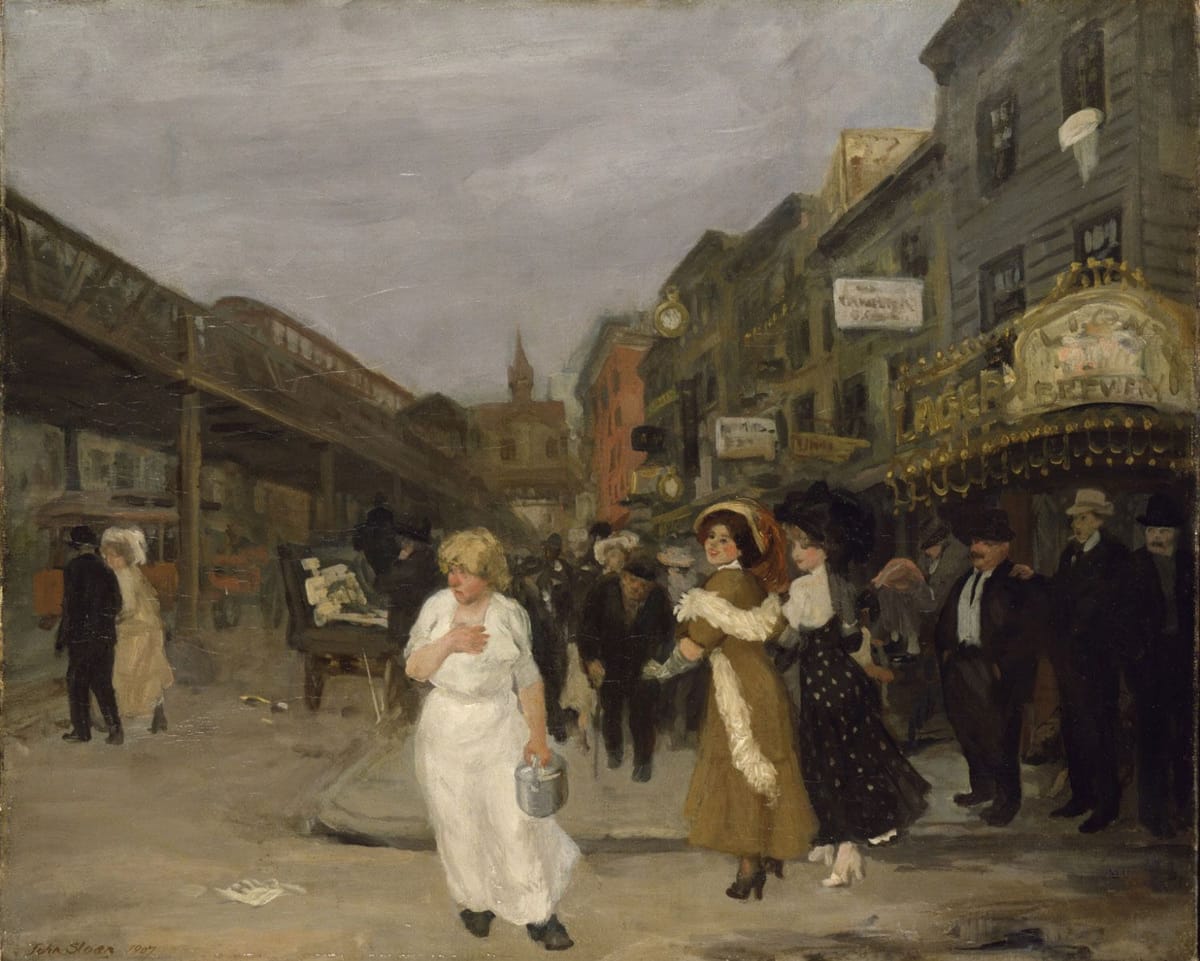A Tale of Two Mayors. Mamdani, Polarizing Beliefs, and our hope for New York City
New York’s new mayor will have to embody two cities: one that dreams of justice, and another that counts the cost. Between compassion and competence lies the struggle that will define whether this age of belief becomes an age of folly.

It was the best of times, it was the worst of times, it was the age of wisdom, it was the age of foolishness, it was the epoch of belief, it was the epoch of incredulity, [...] in short, the period was so far like the present period, that some of its noisiest authorities insisted on its being received, for good or for evil, in the superlative degree of comparison only. — Charles Dickens, A Tale of Two Cities (1859)
On election night, New York chose a story for itself. In bars from Astoria to Bushwick—where the line between rally and DJ set turns porous—young transplants posted videos of strangers hugging on sidewalks. They spoke of free buses and public groceries, of a city that would finally belong to its residents rather than its ill-defined oligarchy. In other neighborhoods, a different New York read the same returns as a warning. Admiration for the city’s exuberance was checked by a familiar unease: can rhetoric of care survive the arithmetic of a budget? “A tale of two mayors,” friends wrote in group a chat—hopes for New York City imagined either by a coalition of hopeful, credentialed newcomers; or by natives and long-timers who prize order, enterprise, and incremental reform. The same man, Zohran Mamdani, will have to refract through two civic sensibilities that barely speak to each other to be a mayor for the whole city.
This contest was never merely municipal. It was a referendum on a style of politics—moralized, maximalist, and nationalized—that now floods local life. Polarization is no longer the exclusive property of cable panels; it is a way of inhabiting the city. It was exceptionally clear what Liliana Mason argues, modern partisanship has become a “mega-identity,” fusing moral tribe, lifestyle, class aspiration, and aesthetic cue (Liliana Mason, Uncivil Agreement, 2018) - all was there. A mayoral race becomes a proxy war over who we are.
A mayoral race becomes a proxy war over who we are.
If early crosstabs are right, the coalition powering Mamdani skewed toward recent arrivals and the highly educated. That is not mysterious. The “credentialed precariat”—graduates with rising cultural capital but faltering balance sheets—has filled blue cities since the late 2000s. Politically intense and economically anxious, they want relief from rent and transit costs and, no less, a vocabulary of belonging to redeem the loneliness of urban life. A politics that promises rent freezes, fare-free buses, and city-run staples translates spreadsheets into solidarity. The 10$ matcha latte, often lampooned, is less a punchline than a totem: a generation that knows it is precarious, and would trade clever consumption for dependable community.
The “credentialed precariat”—graduates with rising cultural capital but faltering balance sheets—has filled blue cities since the late 2000s. Politically intense and economically anxious, they want relief from rent and transit costs and, no less, a vocabulary of belonging to redeem the loneliness of urban life.
In one sense, this is restorative. Simone Weil “rootedness” a human need that modern societies consistently ignore. Mamdani’s language of “a city for all” speaks directly to that hunger. The movement’s rituals—co-ops and community gardens, mutual-aid Slack channels, weekend canvasses that become weeknight potlucks—offer moral texture in a metropolis that often feels like an engine of isolation.
The counter-story is also real. To many small landlords, late-career professionals, union households with mortgage payments, and borough-born voters who remember the city’s fragility in the 1970s, the new program sounds like gravity defiance. Freeze rents too long and you punish maintenance and choke supply. Make transit free without durable revenue and you politicize the MTA’s deficits. Hike top-end taxes sharply and you may not scare away the ultra-rich, but you will bruise the modestly successful—the outer-borough accountant, the school principal, the small electrician who hires two apprentices.
The point is not that every worry is right; it is that New Yorkers remember. This city is littered with plans presented as collective uplift that delivered gains to a narrow, nimble few.
The point is not that every worry is right; it is that New Yorkers remember. This city is littered with plans presented as collective uplift that delivered gains to a narrow, nimble few. Urban renewal, Jane Jacobs warned, too often became sacking a city under the gloss of order (Jane Jacobs, The Death and Life of Great American Cities, 1961). Decades later, abatements written to spur affordability matured into windfalls for luxury development. Lofty schemes, local monopolies, and political intermediaries have a way of converging in New York.
Add a third rail: Israel–Palestine and Socialism. Mamdani’s repeated use of genocide to describe the Gaza war—and his refusal to affirm Israel as an explicitly Jewish state—split Democratic New York along a generational fault. Younger Jews rallied to affordability and civil-rights planks; older and more observant communities recoiled at the foreign-policy stance. Same with the highly contentious ideology of socialism. Psychologists call this the politics of sacred values—commitments people will not trade, even for large material gains. “Morality binds and blinds” Haidt reminds us in The Righteous Mind. Once politics touches the sacred, empathy contracts and rhetoric absolutizes.
For a mayor of a city of tribes, the risk is obvious: what inspires one set of citizens as moral clarity registers to another as existential threat.
For a mayor of a city of tribes, the risk is obvious: what inspires one set of citizens as moral clarity registers to another as existential threat. Pluralism requires the discipline of public explanations that dignify opponents and don't abandon their conscience.
But let's strip away the questions on morality and ask the pragmatic: who wins, who loses?
- Rent freeze. Clear winners: long-tenured renters with stable income. Likely losers: small landlords under maintenance pressure and newcomers rationed by a tighter vacancy chain. Evidence from San Francisco’s 1990s expansion of rent control shows landlords reducing rental supply by about 15% through conversions and redevelopment, raising citywide rents roughly 5%. The lesson isn’t to abandon completely protections, remodulate them; and pair them with aggressive, legal, and fast new supply.
- Fare-free buses. Clear winners: daily riders in transit-dependent neighborhoods. The bill, however, is not imaginary: bus and rail fares and tolls are a major operating pillar; eliminating one leg without dedicated replacement risks slower headways and deferred maintenance. The fairest first step is speed—bus-only lanes, signal priority, all-door boarding—then targeted fare relief for specific demographic groups, where need is clearest.
- City-run staples (groceries, childcare). The benefits could be tangible—but only in theory. History suggests that municipal “public option” projects rarely stay public for long: they begin as instruments of equity and end as experiments in patronage. Without strict transparency, independent oversight, and protection from political interference, city-run stores and childcare centers risk becoming soft monopolies—bureaucratic fiefdoms that serve well-connected operators rather than the families they were meant to help. In New York’s machine politics, goodwill is a scarce commodity; contracts and access are not. Unless governance is lean, competitive, and accountable to both newcomers and legacy residents, these programs will not democratize scarcity—they will simply redistribute privilege under a moral banner.
The pattern is familiar to anyone who has watched New York politics long enough.
Ambitious programs that promise to serve “everyone” often end up serving the best organized. A small circle of contractors, consultants, and advocacy groups learns how to capture the subsidies, steer the zoning decisions, or manage the new public ventures. Over time, the movement that began in the name of the people develops its own hierarchy—campaign donors become advisers, advisers become gatekeepers.
For scholars of polarization, the Mamdani election encapsulates several defining traits of today’s political landscape—each revealing how identity and emotion now structure democratic life more than policy or ideology.
1. Identity first, policy later. As political scientist Lilliana Mason observed in Uncivil Agreement (2018), partisanship has fused with social identity. Voters no longer weigh candidates mainly by their platforms but by who they are—their religion, ethnicity, gender, class style, and tone. Policy preferences are often adjusted afterward to align with the emotional pull of belonging. In the Mamdani race, debates over rent freezes or public transit mattered less than what his persona symbolized: a young, Muslim, left-leaning reformer challenging the establishment.
2. Generational sorting. Data from the Pew Research Center’s Political Typology Report (2021) shows widening divides between younger and older voters in moral outlook as well as economics. Younger New Yorkers embraced Mamdani’s calls for redistribution, climate justice, and global solidarity, seeing in Gaza or housing the same moral continuum of care. Older voters, shaped by the crises and recoveries of the 1970s and 1980s, placed greater weight on stability, order, and earned merit. This is not simply left versus right—it is a clash of moral intuitions about what a just city looks like.
3. The moralization of local politics. Municipal elections once revolved around competence—trash collection, transit, zoning. Today they serve as proxies for national and even international battles. Issues like Gaza, policing, and climate policy became moral touchstones in the New York mayoral race, transforming a city administrator into an avatar of conscience or threat. The influx of moral energy brings passion and participation, but it also replaces the patient work of coalition-building with crusade politics, where compromise feels like betrayal.
4. Weaker elite mediation. Finally, the Mamdani campaign confirmed how traditional party hierarchies have lost their gatekeeping power. Democratic elders hesitated to endorse him; digital organizers, small donors, and social media influencers did not. What once depended on machine backing now depends on viral authenticity. The new politics rewards narrative over networks, charisma over caution. Yet without mediating elites to negotiate between factions, the city risks governing by momentum—quick to ignite, slow to govern.
Together, these four dynamics show why polarization today feels a social architecture: one where identity signals, generational values, moral fervor, and leaderless movements interact to shape not just national elections but the moral mood of cities themselves.
If Mamdani’s New York hopes to avoid the cyclical tragedy—great hopes, narrow spoils—it must match moral ambition with pluralist engineering:
- Build relentlessly—and legally. Legalize more housing everywhere: gentle density near transit, mid-rise on wide avenues, commercial-to-residential conversions. Streamline approvals that turn each building into a trench war. Evidence is consistent: new supply lowers nearby rents and creates “chains” that open mid- and lower-tier units (Brian Asquith, Evan Mast, Davin Reed, Upjohn Institute Working Paper, 2019; Evan Mast, Journal of Urban Economics, 2023).
- Make buses faster before making them free. Time is the first equity. Bus lanes, signal priority, and lane enforcement deliver benefits tomorrow; then expand targeted discounts and, if the books permit, broader fare relief tied to named, durable revenue.
- Fight capture on the left and right. Build sunset clauses and independent evaluations into major initiatives; publish distributional audits so New Yorkers can see who actually benefits. If a public grocery pilot becomes three protected shops with political patrons, end it.
- Invest in civic intermediaries. The most effective depolarizers are not “dialogue workshops” but institutions that force cooperation on concrete tasks: PTAs that run after-school programs, park conservancies, neighborhood safety partnerships, faith-based service coalitions. They rebuild trust where people actually meet.
- Re-moralize work. Widen avenues for modest enterprise: licensing reform for small trades, safe-harbor rules for home-based microbusinesses, simple tax regimes for one-person shops, apprenticeships that confer status without debt. Treat the shop-owner and the barista as civic contributors, not revenue sources.
A smart critique of the new administration means telling a rival moral story with equal poetry: that personal responsibility and public order are instruments of care; that work, enterprise, and safe streets are the preconditions of solidarity; that a city welcoming dreamers must remain a city rewarding doers.
A smart critique of the new administration means telling a rival moral story with equal poetry: that personal responsibility and public order are instruments of care; that work, enterprise, and safe streets are the preconditions of solidarity; that a city welcoming dreamers must remain a city rewarding doers.
If Mamdani governs as a mayor rather than a movement leader, he will meet constraints quickly. The MTA belongs to Albany; tax changes require state assent; rent law sits behind independent boards. The temptation will be to substitute symbolic clashes for deliverables—to cultivate enemies instead of solving problems. Here the father’s scholarship offers an unintentional warning. Mahmood Mamdani has spent a lifetime charting how modern states manufacture “permanent minorities”—friend and foe as constitutive categories (Mahmood Mamdani, Neither Settler nor Native, 2020). New York does not need permanent minorities of the urban imagination—drivers versus cyclists, landlords versus tenants, “newcomers” versus “real New Yorkers.” It needs a mayor who refuses that dramaturgy.
New York does not need permanent minorities of the urban imagination—drivers versus cyclists, landlords versus tenants, “newcomers” versus “real New Yorkers.” It needs a mayor who refuses that dramaturgy.
For critics, the obligation is symmetrical. Resist treating every experiment as apocalyptic. When a bus pilot yields data, read it. When a tenant program deters harassment, expand it. When something fails, admit it early. The city deserves adversaries who bargain, not arsonists who brand.
New York now carries two mayors within the same man. One speaks in the poetry of justice, promising a moral city reborn through care and equality. The other must learn to live in prose—budgets, payrolls, contracts, and the arithmetic of limits. If the idealist consumes the administrator, the city will drift into symbolism and then into the quiet decay that follows every overreaching reform. But if the administrator silences the idealist, New York will return to what it knows too well: managerial stagnation disguised as prudence.
Jane Jacobs once wrote, that cities have the capability of providing something for everybody, only because, and only when, they are created by everybody. (Jacobs, The Death and Life of Great American Cities, 1961). That remains the only credible measure of progress. If, two years from now, the “everybody” in her sentence is broader—if newcomers and natives, renters and owners, the devout and the secular, the matcha crowd and the deli counter all feel more visible in the city’s moral imagination—then Mamdani’s New York will have achieved something real.
But if the experiment collapses into old habits—ideals monopolized by a few, benefits captured by the same insiders—it will confirm what every generation learns anew: that good intentions are no match for institutional gravity. Raymond Aron warned that ideology dulls the intellect; the cure is not cynicism but realism infused with conscience. For New York, that means holding both sides of what a mayor should be in balance—the dreamer and the steward, the reformer and the realist—so that the city can remain what it has always been at its best: restless, imperfect, and still capable of renewal. ◳





